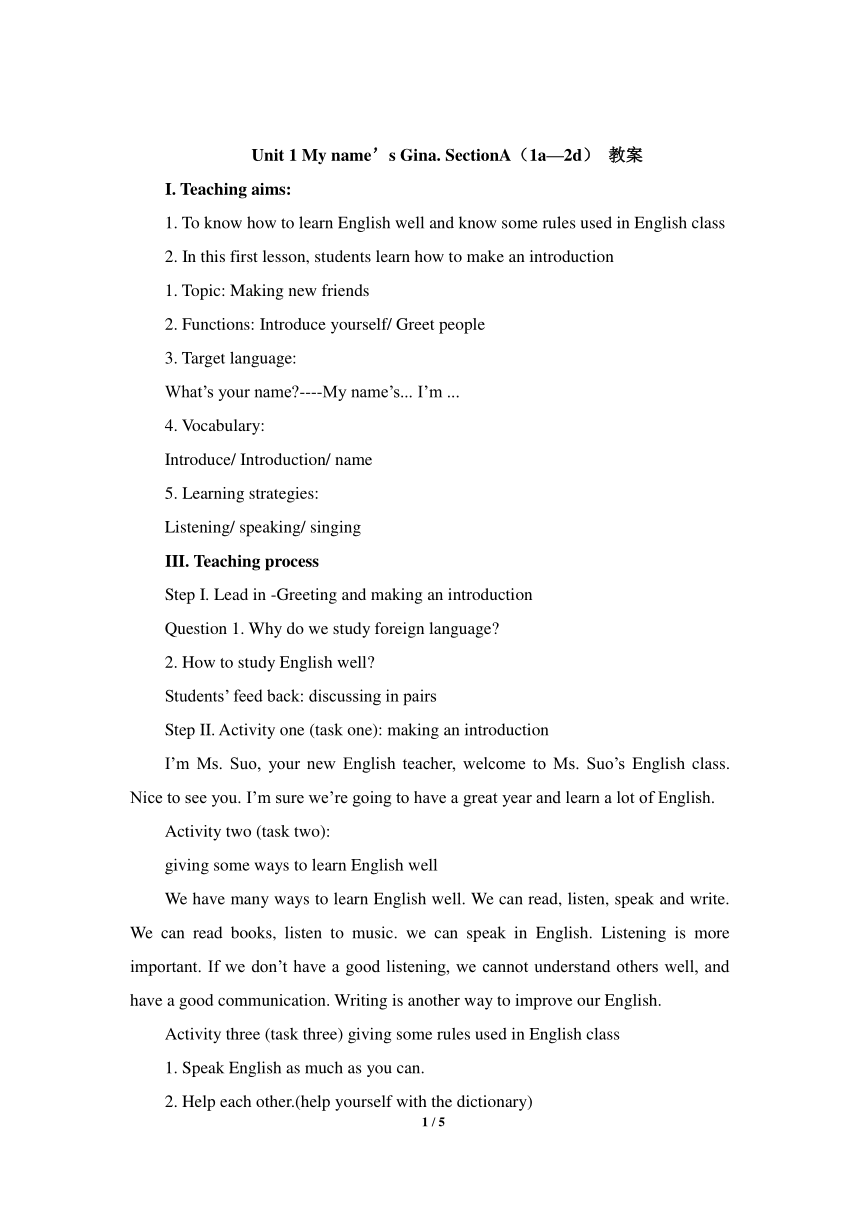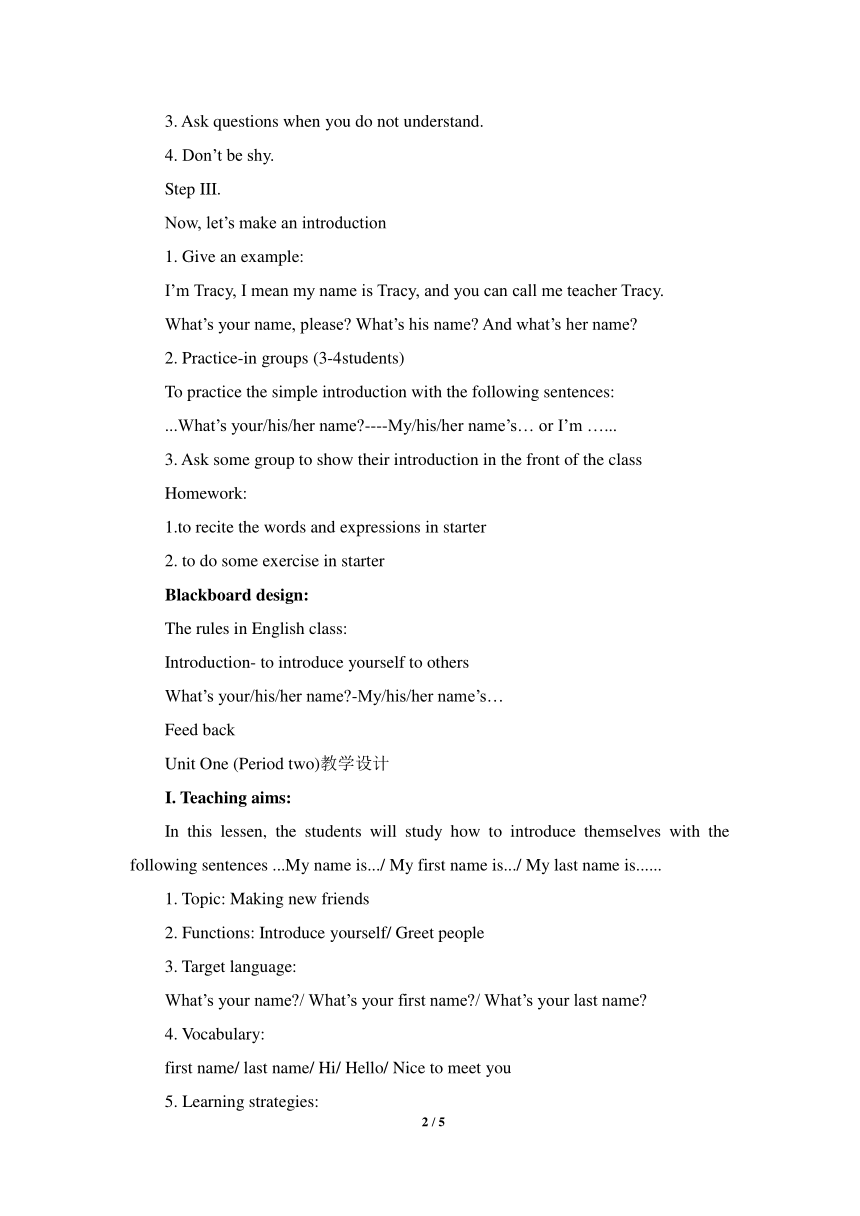Unit 1 My name’s Gina. SectionA(1a—2d) 教案
文档属性
| 名称 | Unit 1 My name’s Gina. SectionA(1a—2d) 教案 |  | |
| 格式 | zip | ||
| 文件大小 | 44.0KB | ||
| 资源类型 | 教案 | ||
| 版本资源 | 人教新目标(Go for it)版 | ||
| 科目 | 英语 | ||
| 更新时间 | 2019-10-15 11:10:46 | ||
图片预览


文档简介
Unit 1 My name’s Gina. SectionA(1a—2d) 教案
I. Teaching aims:
1. To know how to learn English well and know some rules used in English class
2. In this first lesson, students learn how to make an introduction
1. Topic: Making new friends
2. Functions: Introduce yourself/ Greet people
3. Target language:
What’s your name?----My name’s... I’m ...
4. Vocabulary:
Introduce/ Introduction/ name
5. Learning strategies:
Listening/ speaking/ singing
III. Teaching process
Step I. Lead in -Greeting and making an introduction
Question 1. Why do we study foreign language?
2. How to study English well?
Students’ feed back: discussing in pairs
Step II. Activity one (task one): making an introduction
I’m Ms. Suo, your new English teacher, welcome to Ms. Suo’s English class. Nice to see you. I’m sure we’re going to have a great year and learn a lot of English.
Activity two (task two):
giving some ways to learn English well
We have many ways to learn English well. We can read, listen, speak and write. We can read books, listen to music. we can speak in English. Listening is more important. If we don’t have a good listening, we cannot understand others well, and have a good communication. Writing is another way to improve our English.
Activity three (task three) giving some rules used in English class
1. Speak English as much as you can.
2. Help each other.(help yourself with the dictionary)
3. Ask questions when you do not understand.
4. Don’t be shy.
Step III.
Now, let’s make an introduction
1. Give an example:
I’m Tracy, I mean my name is Tracy, and you can call me teacher Tracy.
What’s your name, please? What’s his name? And what’s her name?
2. Practice-in groups (3-4students)
To practice the simple introduction with the following sentences:
...What’s your/his/her name?----My/his/her name’s… or I’m …...
3. Ask some group to show their introduction in the front of the class
Homework:
1.to recite the words and expressions in starter
2. to do some exercise in starter
Blackboard design:
The rules in English class:
Introduction- to introduce yourself to others
What’s your/his/her name?-My/his/her name’s…
Feed back
Unit One (Period two)教学设计
I. Teaching aims:
In this lessen, the students will study how to introduce themselves with the following sentences ...My name is.../ My first name is.../ My last name is......
1. Topic: Making new friends
2. Functions: Introduce yourself/ Greet people
3. Target language:
What’s your name?/ What’s your first name?/ What’s your last name?
4. Vocabulary:
first name/ last name/ Hi/ Hello/ Nice to meet you
5. Learning strategies:
Listening/ speaking/ singing
III. Teaching process
Step I. Lead in
Question 1. What’s your name, please./ May I have your name, please?
2.What’s your last name? / What’s your first name?
3.If you want to show your politeness, what do you usually say when you first meet someone?
Students’ feed back: discussing in pairs
Step II. Learn and Practice
Activity one (task one) listen the tape and do the exercise: Section A-1b:Play the Recording for the first time. Students only listen. Focus attention on the example: the conversation numbered(1). Point out the boxes where students will write a number for each conversation. Play the recording a second time. Students number the conversations.Sec.A-2a: Play the recording for the first time. Students only listen. Point to the boxes next to the pictures. (say: listen to the four conversations again. Write the number 1 in the box next to the people who say conversation 1, 2 in the box next to the people who say conversation2,etc.), 2b:Point the words in the box, (say: listen for these names in the conversations. You will hear some of the names, not all of them. circle the names you hear. The first one is done for you.)
Activity two (task two)
Do the exercise- Sec.B-3a: Read the list of names in the exercise. Ask students to guess which names are first names and which are last names. (Tell students your given name and your family name. Explain that, in English, your given name is referred to as your first name and your family name is referred to as your last name, or surname. The family name is written after one's given name, then point to individual students and say first name or last name, asking them to respond by saying their given name or family name.) Sec.A-3b: Ask the students to choose a first name and a last name that they like from 3a.
Activity three (task three) Game: This is a team game. The last student of each team is the leader this time. I’ll ask a question to the first student like this. Then, the first student answers my question and turns back to ask the second student the same question. Well, see. Just like this.
Teacher: Hi, nice to meet you. I’m Tracy. Tracy is my first name and Xu is my last name. What’s your name? Student1: My name is Li Lei. (turn back to the next student) Nice to meet you, her name is Tracy Suo, and I’m Zhang Meng. My last name is Zhang and my first name is Meng. What’s your name?
Student2: Nice to meet you, too. My name is Liu Xing. (turn back to the next student) His name is Li Lei. And her name is Tracy Suo. I’ m Liu Xing. My last name is Liu and my first name is Ying. What’s your name?
At the end of the group, the leader who can tell the names as many as he can is winner.
Culture note-English names vs. Chinese names Unlike Chinese names, English names are listed with the given name first and the family name or surname second. Many people have two given names, e.g. Sara Ann Smith. The second name is called the middle name and has no real significance, unlike the Chinese second name which indicates a child’s generation. English family names are inherited from the father, and a woman’s family name changes to the family name of her husband when she marries. Chinese women do not necessarily take their husband’s family name when they marry. Many English names have and old meaning, but the meaning is not usually a consideration when choosing a name, the way the name sounds is more important. In Chinese culture, naming a child often takes five principles into consideration: the name should reflect favorable mathematical calculations, be harmonious with regard to yin and yang, and possess one of the five elements of metal, water, wood, fire, and air.
Activity four (task four) Sing an English song ...The More We Get Together... .The more we get together, together, together, the more we get together, the happier we’ll be! For your friends are my friends and my friends are your friends, the more we get together, the happier we’ll be! Step III. Production
Task one: It’s warming up, the students think the questions that teacher gives and step in the situation-...Greeting... and ...Introduction....
Task two: Do exercise and practice in book. Moreover, learn how to ask names.Task three: Practice the greeting ...nice to meet you..., introduction and the first name, last name.
Task four: Relaxing
Step IV. Sum-up
1. The whole class practices how to greet people and introduce each other.
2. Learn the difference between Chinese culture and western culture.
3. Learn a beautiful English song.
Homework:
1.Listen to tape of Unit1
2.Review the starter and do some exercise:P1 Sec.A-1a; P4 Sec.B-1a,2; P6-1; P7 Sec.A-1a; P10 SecB-1a; P11-3a; P12-1; P13 Sec.A-1a; P18-1; P19- 1a; P24-1; P25 SecA-1a; P30-1,2,3.
3. Review the Grammar Focus in Starter
Blackboard design:
2 / 2
同课章节目录
- starters 预备篇(2012秋审查)
- Unit 1 Good morning !
- Unit 2 What’s this in English?
- Unit 3 What color is it ?
- Unit 1 My name's Gina.
- Section A
- Section B
- Unit 2 This is my sister.
- Section A
- Section B
- Unit 3 Is this your pencil?
- Section A
- Section B
- Unit 4 Where's my schoolbag?
- Section A
- Section B
- Unit 5 Do you have a soccer ball?
- Section A
- Section B
- Unit 6 Do you like bananas?
- Section A
- Section B
- Unit 7 How much are these socks?
- Section A
- Section B
- Unit 8 When is your birthday?
- Section A
- Section B
- Unit 9 My favorite subject is science.
- Section A
- Section B
